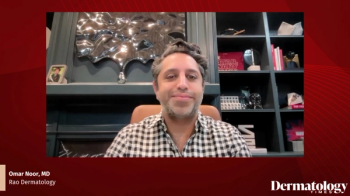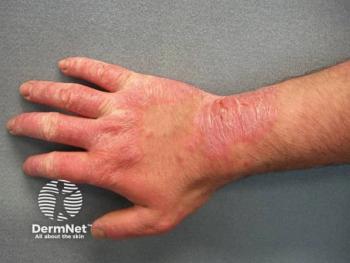
- Dermatology Times, May 2025 (Vol. 46. No. 05)
- Volume 46
- Issue 05
Advancing Atopic Dermatitis Treatment by Understanding the Role of Multitargeted Therapies
Key Takeaways
- Atopic dermatitis affects approximately 7% of adults, with 40% experiencing moderate to severe disease that is often inadequately controlled.
- JAK inhibitors are emerging as effective therapies for moderate to severe AD, offering advantages by targeting multiple immune pathways.
Explore the evolving landscape of dermatology as experts emphasize the importance of cross-specialty collaboration and patient-centered care in aesthetic medicine.
In a recent Dermatology Times Clinical Case Collective custom video series,
The collective presented a thorough exploration of current treatment options, patient management strategies, and real-world scenarios that illustrated the pressing challenges many clinicians face. The discussion, featuring experts Lisa Swanson, MD; Linda Stein Gold, MD; James Song, MD; and James Del Rosso, DO, included insights into the burdens of the disease and the significant impact of innovative therapies like JAK inhibitors on treatment pathways.
The Clinical and Emotional Burden of AD
The panel began by addressing the epidemiology and burden associated with AD. Swanson, a pediatric dermatologist practicing at Ada West Dermatology in Boise, Idaho, pointed out that approximately 7% of adults are estimated to have some form of AD, with approximately 40% of those individuals suffering from moderate to severe disease that remains inadequately controlled. “More than 55% of adults with moderate to severe disease are not adequately controlled and need our help,” she noted, highlighting the critical need for effective therapeutic options.
The psychosocial implications of inadequate disease control cannot be overstated, according to the panel. The visible nature of AD often leads to emotional distress, social stigma, and challenges in self-image. The panel emphasized that treatment strategies must account not only for the physical manifestations of AD but also for its emotional and social impacts.
Deciding on Treatment Options
Determining appropriate treatment pathways for AD remains a nuanced process that involves multiple variables, including the severity of the disease and patient-specific factors.
Stein Gold, director of dermatology clinical research at Henry Ford Health System in Detroit, Michigan, emphasized the importance of context in defining moderate to severe AD: “The proxy that we use is: Did they ever receive a systemic therapy? If they did, that’s moderate to severe.” This highlights the importance of comprehensive patient evaluations beyond labeling based solely on clinical trials or body surface area measurements.
Del Rosso, a clinical dermatologist and research leader based in Las Vegas, Nevada, noted the limitations of relying on traditional clinical criteria alone and emphasized the need to do better in capturing patient experiences. “We have newer nonsteroidal agents, but none of these things necessarily get the patient under control,” Del Rosso remarked. He added that understanding patients’ prior treatments and frustrations is key to guiding the next steps.
Real-World Cases: Insights Into Decision-Making
The panel also discussed real patient cases to illustrate the decision-making process in AD treatment. One case involved an adult woman with significant disease activity despite multiple previous treatments. Del Rosso advocated for individualized selections based on patient-living experiences, stating, “I want to get them off the hamster wheel,” referring to the complex and often ineffective regimens many patients endure.
Another case featured a pediatric patient struggling with moderate AD. Through these examples, the clinicians conveyed the importance of tailoring treatment to patient-specific needs, including disease progression, emotional resilience, and prior therapy outcomes.
The Role of JAK Inhibitors in AD Management
A significant focus of the panel was the emerging role of JAK inhibitors in AD management. Swanson articulated their advantages: “I think the real advantage that we have with JAK inhibitors is that we could inhibit multiple different immune accesses.” This reflects a shift in understanding AD as a heterogeneous disorder, with diverse cytokine profiles contributing to varied patient responses.
Del Rosso expanded on this: “In my opinion, and I think we have some data to support this, oral JAK inhibitors, at least some of the ones that we have here in the US, abrocitinib and upadacitinib, are the most effective therapies for moderate to severe AD.” He referenced multiple network meta-analyses demonstrating their superior outcomes compared with historical treatment modalities.
Safety Considerations With Newer Therapies
Despite enthusiasm for newer therapies, the panelists stressed the importance of monitoring safety. Stein Gold discussed the benefit of targeting specific pathways: “If we want to more holistically affect the broad nature of any type of dermatitis in general,” she said, “targeting JAK1 offers promising safety and efficacy profiles tailored to AD management.”
Song, director of clinical research and associate chief medical officer at Frontier Dermatology in Mill Creek, Washington, also pointed out that treatment responses may vary significantly across patient populations. “We know that AD is a very heterogeneous disorder,” he said. “We like to compare it to psoriasis, much more homogeneous, IL-23 to IL-17 driven. But we have really good data to show that based on your age, your race, whether you have certain comorbidities, like your cytokine profile, it could look quite different.” This evolving understanding of AD highlights the importance of integrating demographic and biological variability into treatment decisions.
Integrating Patient Perspectives Into Treatment Plans
As the discussion progressed, the importance of shared decision-making in treatment planning became increasingly evident. The clinicians agreed that listening to patients’ preferences, concerns, and emotional responses can significantly influence the success of therapy.
Swanson acknowledged the difficulty some patients, particularly pediatric and adolescent patients, have in advocating for themselves: “I want the patient to speak for themselves, but sometimes they can’t.” The group emphasized the value of discussing various treatment routes, including oral vs injectable therapies, and helping patients navigate fears or misconceptions. This collaboration supports a more empowering, informed, and successful patient journey.
Evolving Approaches to Successful AD Management
The panel’s insights culminated in a collective understanding of the dynamic landscape of AD management. With emerging therapies like JAK inhibitors, they encouraged fellow clinicians to integrate these advancements into their practices while keeping the patient’s experiences at the forefront.
The panel emphasized the need for continuous adaptation in treatment approaches, calling for a balance between innovation and personalization. By exploring these nuanced discussions, clinicians gain a richer understanding of the strategies essential for effectively managing AD and improving long-term patient outcomes.
Articles in this issue
Newsletter
Like what you’re reading? Subscribe to Dermatology Times for weekly updates on therapies, innovations, and real-world practice tips.



















